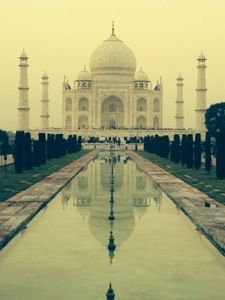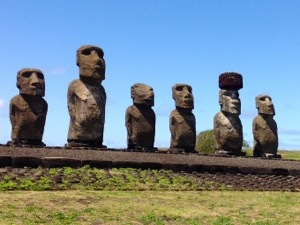
by Loti | Nov 24, 2013 | Architecture, Environment, India, Wonder of the World, World heritage Sites
India. Mark Twain, after visiting the Taj Mahal, said the world is split in two parts-those that have seen the beautiful monument and those that have not. I am now one of the lucky ones. Along with approximately 50,000 other visitors a day. Considered by many (including me) to be the most beautiful building in the world, this World Heritage Site is at risk of being damaged by modern pollution. Built in 1632 with no electricity, power tools, trucks or other modern day conveniences, it took 20,000 workers (building and crafting 24 hours a day) over 20 years to build. It completely boggles my mind! Yet in the last century, air pollution has been eating away at the white marble exterior and water pollution threatens the foundations on which the mausoleum is built. Pollution monitoring devices are everywhere, no gas powered vehicles are allowed within a half mile of the Taj Mahal and nearby coal based factories have been closed or converted to natural gas. But alas, all the pollution monitoring devices don’t work without electricity, which was off routinely for 6-10 hours a day due to power outages during our visit. And when the power is out, diesel generators kick on to supply power which just adds to the pollution. Old meets new. With no easy solutions, it is an interesting juxtaposition (my lexicon for the...

by Loti | Nov 6, 2013 | Africa, Animals, Conquering Fear, Wonder of the World, World heritage Sites
Kenya. So I have to admit I was somewhat apprehensive about going to Kenya after the Sept mall attack. Ok, more like terrified. Lions, tigers and terrorists, oh my! Adding to my anxiety was the maze of airport parking lots we walked through at the Nairobi airport after landing. Past the charred, empty buildings of the international terminal. Charred buildings! Apparently I was one of the few who hadn’t heard about the massive electrical fire at the airport in Aug. After boarding our turbo prop plane (triple yikes) for the 45 minute flight to the Maasi Mara game preserve, I finally breathed. At this point I am wondering why we just couldn’t fly in on the private jet and then I saw our landing strip below (pictured here). Now I get it. I am doomed! Of course we made a perfect landing. And so began the most memorable experience of my life, the migration of over 1.5 million wildebeest, zebra and gazelle with a few warthogs, hyenas, lions, giraffes and baboons thrown in. Although we were at the end of the season, I have since learned the migration is considered one of the Seven Wonders of the World (according to USA Today). So by experiencing sheer terror, came sheer joy. The coolest gift of...

by Loti | Oct 15, 2013 | Architecture, Easter Island, Landscapes, Wonder of the World
Easter island. Remote does not even begin to describe this fascinating island. The closest inhabited island is Pitcairn Island with 50 inhabitants located 1300 miles away. Mainland Chile is over 2,100 miles, a 6 hour plane ride. Yet it boasts one of the longest runways in the Pacific thanks to the US space program. In 1986, the US extended the runway in both directions to serve as an emergency landing spot if the space shuttle got into trouble after liftoff. And mystery surrounds the island. No one is really sure of how and when the island was settled. Archeologists disagree when the island was inhabited first, with varying estimates of 300 AD to 1200 AD. At one point there were 10,000 to 20,000 residents, however by 1877 there were only 111 residents left. And then there are the Moai, the ancient statues which bring so many to Easter island. How were they made, moved, toppled? We have much to still learn about this fascinating island. I thought I would find answers on visiting it first hand, but only came away with more...

by Loti | Apr 23, 2013 | Africa, Conquering Fear, Landscapes, Wonder of the World, World heritage Sites
Africa. What an awe inspiring sight! Hovering above Victoria Falls in a helicopter (this was definitely way outside my comfort zone), we could see the mist surrounding the falls. And walking the trails around the falls, you hear the thunder of the water, feel the damp spray and try to dodge the monkeys. Just amazing. Called the Smoke that Thunders by the locals, the falls lie on the border of Zimbabwe and Zambia in Southern Africa. Discovered by David Livingstone (the Scottish missionary and physician who was greeted with the famous phrase, “Dr. Livingstone, I presume”), they are named after Queen Victoria of England. Over 1 mile wide and 350 feet high, they are the one of the largest waterfalls on the planet and are designated a World Heritage site. They are also included on the list of the Seven Natural Wonders of the World published by CNN. Which I found fascinating, because on doing some research, there are multiple lists of the Seven Wonders of the World. And each is different. There is the Ancient Seven Wonders, the Natural, the Medieval, the New Seven Wonders, the Modern, the Industrial, the Underwater and even the Animal Seven Wonders (which includes butterflies and magpies). So much to do and see and...





